|
MobileDemand xTablet T1270
High-performance rugged 12.2-inch Windows tablet with PCIe storage and available Intel RealSense depth camera system
by Conrad H. Blickenstorfer
Ever since the company's start in 2003, MobileDemand of Hiawatha, Iowa, has been providing rugged tablet PCs to make businesses more productive. They did that with a clear focus on making available practical, affordable hardware and solutions to get the job done. There's a good degree of down-to-earth Midwestern common sense in the company, the kind that fosters confidence, trust and good business relationships.
But that's not all there is to MobileDemand. The company also has shown a remarkable willingness to explore new business opportunities and investigate interesting technological innovations. Examples of the former include rugged cases for Microsoft Surface and rugged case for iPad (Apple). Examples of the latter are new display technologies, three-dimensional data capture and, most recently, leapfrogging new storage technology.
Which brings us to MobileDemand's new xTablet T1270, the company's biggest and most powerful tablet PC to-date, and one that may well contribute to redefine tablet PC customer expectations.
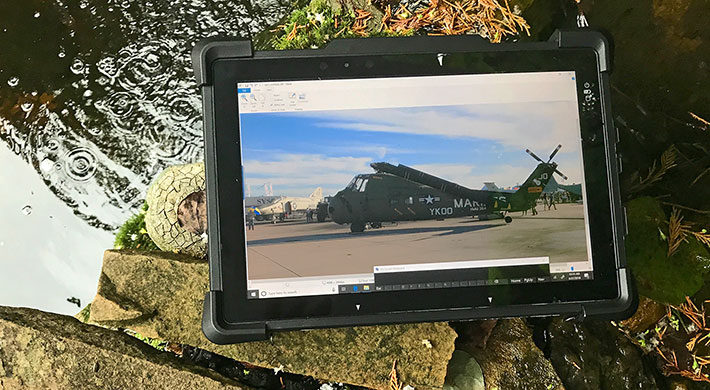
The need for a big, powerful tablet
We're not sure how the xTablet T1270 came about. Maybe those enterprising minds at MobileDemand got together and figured that light and handy tablets with 8 and 10 inch screens worked great for many tasks in the field and in factories where dedicated, touch-optimized software is used to collect data within Microsoft IT infrastructures. But that for other work — logistics, planning, positioning, financial, or advanced project work come to mind — a tablet with a larger screen is better, as is the performance users generally expect from a desktop or big laptop.
Not many tablets can meet that challenge. In fact, while the average desktop monitor measures over 22 inches diagonally, and the average laptop screen about 16 inches, most tablets are quite small, with just a few over 12 inches. And for thermal management reasons, most of the small Windows tablets are limited to lower-end Intel processors.
So what did MobileDemand come up with? In essence, a tablet that provides a larger screen and more performance for power users. The xTablet T1270's screen measures 12.2 inches diagonally. That's the biggest screen MobileDemand has ever offered. It's bigger than the 11.6-inch tablets several of MobileDemand's competitors offer, and about the same size as Microsoft's Surface Pro tablets with their 12.3-inch screens.
As far as performance goes, MobileDemand also swung for the fences. We're talking Intel 7th Generation "Kaby Lake" technology, with a Core i5-7200U standard, bracketed by a "low-end" Celeron 3965U and a high-end Core i7-7500U. And here's what it all looks like:
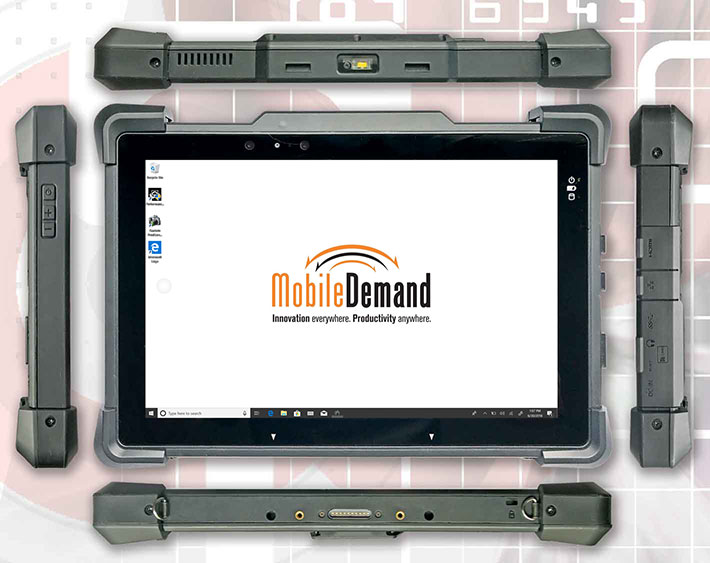
The xTablet T1270 is a functional, purposeful, no-nonsense design with a large hardened and well-protected glass front, a black plastic case, sturdy replaceable black rubber bumpers, and protective covers for all ports. The bezel space around the LCD part of the display is wide enough to hold the tablet without triggering a touch command, and except for the slightly protruding rubber bumpers there is no border for fingers to bump into while operating the tablet.
On top of the unit is the grill for a small fan. While we prefer fanless designs in the field, having Intel Core performance — and maintaining it when it gets hot — does require active cooling. Note that the fan is waterproof and the fan compartment is sealed against the interior.
Along the left side are the power button and a small audio volume rocker. On the back are three programmable function buttons. Their functions include operating the bar code scanner and putting the device into stealth mode.
On the bottom is a surface-mount "Pogo" docking connector for use with one of the two available docks. It provides power pass-through, HDMI, serial, and USB 3.0. Flanking that are two mounting/security screw holes.
Equipping a rugged tablet with onboard ports is a challenge because there isn't much space, and sealing requirements favor designs with as few openings to the inside as possible. A Windows-based enterprise tablet, however, needs at least a minimal degree of onboard connectivity, and below you can see what the T1270 offers:

Almost all I/O is concentrated in a recessed area on the right side of the tablet. You get, from right to left, a micro-HDMI port, a gigabit RJ45 LAN jack, a full-size USB 3.0 port, a 3.5mm audio jack, and the power jack.
There are undoubtedly those who would have liked to have additional onboard wired I/O; full-size HDMI perhaps, or a legacy serial port, a second USB 3.0 port, or one of those new USB Type C ports. But the number of ports is one of the compromises MobileDemand had to make.
State-of-the-art performance
While the majority of MobileDemand's rugged tablet PC offerings provide enough performance for their targeted applications at an attractive price point, with the T1270 the company aims far higher on the performance scale with a choice of three Intel 7th generation "Kaby Lake" processors.
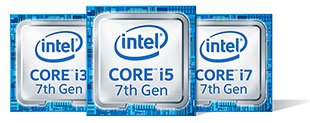 Built on 14 nm process technology, "Kaby Lake" is the first high-end Intel processor line that no longer officially supports any OS prior to Windows 10. This allowed Intel to fully optimize the chips for current software technology, including advanced inherent high-res video capability, mostly in the hardware encoding/decoding areas. Built on 14 nm process technology, "Kaby Lake" is the first high-end Intel processor line that no longer officially supports any OS prior to Windows 10. This allowed Intel to fully optimize the chips for current software technology, including advanced inherent high-res video capability, mostly in the hardware encoding/decoding areas.
A new implementation of Speed Shift lets the CPU control turbo frequency instead of the operating system, which means the chip can speed up much faster.
|
MobileDemand xTablet T1270 CPUs (see full specs)
|
Intel Celeron
|
Intel Core
|
Intel Core
|
|
Model
|
3965U
|
i5-7200U
|
i7-7500U
|
|
Code Name
|
Kaby Lake
|
Kaby Lake
|
Kaby Lake
|
|
Availability
|
Option
|
Standard
|
Option
|
|
Lithography
|
14nm
|
14nm
|
14nm
|
|
Cores/Threads
|
2/2
|
2/4
|
2/4
|
|
Base Clock Speed
|
2.20 GHz
|
2.50 GHz
|
2.70 GHz
|
|
Turbo Speed
|
no turbo
|
3.10 GHz
|
3.50 GHz
|
|
Thermal Design Power (TDP)
|
15 watts
|
15 watts
|
15 watts
|
|
Smart Cache
|
2MB
|
3MB
|
4MB
|
|
Instruction set
|
64-bit
|
64-bit
|
64-bit
|
|
Integrated graphics
|
HD Graphics 610
|
HD Graphics 620
|
HD Graphics 620
|
|
Graphics base speed
|
300 MHz
|
300 MHz
|
300 MHz
|
|
Graphics max speed
|
900 MHz
|
1,000 MHz
|
1,050 MHz
|
|
Graphics EUs
|
12
|
24
|
24
|
|
Intel vPro
|
No
|
No
|
No
|
|
Intel Virtualization
|
Yes
|
Yes
|
Yes
|
|
Intel SIPP
|
No
|
No
|
No
|
|
Intel Trusted Execution
|
No
|
No
|
No
|
While mobile computing products often come with a selection of processors that are very close in terms of performance, MobileDemand chose to space its trio of CPUs available for the T1270 fairly wide.
The "low-end" 3965U, while marketed under the Celeron brand, is still a Kaby Lake Core processor, albeit one with less Smart Cache and lacking hyper-threading, turbo boost, as well as a number of instructions. Its graphics subsystem is also less powerful, with only half the number of graphics execution units as the other two chips. This chip is plenty competent, but won't provide the peak performance bursts of the other two CPU options.
The Core i5-7200U is sort of a low end of Intel's mid-range Core processors. It's a modern dual-core, quad-thread chip running at a base frequency of 2.50GHz and a maximum turbo speed of 3.10GHz. This chip should provide nearly twice the computing power of the Celeron (4,640 vs 2,470 v9 CPU Mark, according to cpubenchmark.net).
On the high end, the Core i7-7500U is in essence an even quicker version of the i5-7200U, but the difference is much smaller than that between the i5 and the Celeron. Expect perhaps a 10-12% increased in CPU performance of the 7500U over the 7200U.
The processor, however, is only one part of the performance story. True, Intel some time ago began calling the short-term overclocking of its high-end processors "turbo boost," but there's another kind of turbo boost that's at least as important to overall bottomline system performance as the turbo boost, and it's not time-limited. And that's memory and disk performance.
On the memory side, it's not just RAM speed that matters. It's also the data transfer rate between the memory controller and memory itself. Usually, it's just a single channel, but dual and even quad-channel configurations are possible for a substantial increase of the data transfer rate. MobileDemand uses a dual-channel configuration to optimize performance.
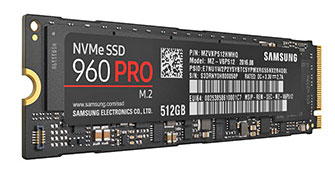 Then there's mass storage. The simple story here is this: in mobile systems, rotating hard disks have largely been replaced with much faster solid state "disks" (they are chips and not disks at all). Now those original SSDs that used a SATA interface are slowly being replaced with much faster PCIe-based SSDs. We got the first taste of PCIe-based disk performance a year ago, Summer 2017, when Xplore sent us their top-of-the-line XSLATE R12 with an Intel PCIe SSD. That tablet scored by far the highest score of any tablet we had ever run through our benchmarks. The performance advantage was so dramatic that we're quite surprised that almost no one quickly switched to PCIe as well.
Then there's mass storage. The simple story here is this: in mobile systems, rotating hard disks have largely been replaced with much faster solid state "disks" (they are chips and not disks at all). Now those original SSDs that used a SATA interface are slowly being replaced with much faster PCIe-based SSDs. We got the first taste of PCIe-based disk performance a year ago, Summer 2017, when Xplore sent us their top-of-the-line XSLATE R12 with an Intel PCIe SSD. That tablet scored by far the highest score of any tablet we had ever run through our benchmarks. The performance advantage was so dramatic that we're quite surprised that almost no one quickly switched to PCIe as well.
But now MobileDemand has, with the xTablet T1270. And with an additional year of PCIe-based storage progress and MobileDemand's use of dual channel memory, just how fast would the T1270 be?
To provide an idea of the kind of performance the xTablet T1270 offers, we ran our standard benchmark suite, Passmark Software's PerformanceTest versions 6.1 and 9.0, that run about 30 tests covering CPU, 2D graphics, 3D graphics, memory, and disk and then computes scores for each category and an overall PassMark score. Since it's almost unfair to compare PCIe storage tablets with those with older SATA SSDs, we just included the only other two PCIe-equipped tablets we've tested, Xplore's R12 and the new Xplore XSLATE L10.
The results are as follows:
|
MobileDemand xTablet T1270 Benchmarks and Comparisons
|
|
PERFORMANCE COMPARISON
|
MobilDemand
|
Xplore
|
Xplore
|
|
Model
|
xTablet T1270 (2018)
|
XSLATE R12 (2017)
|
XSLATE L10 (2018)
|
|
Display
|
12.2-inch
|
12.5-inch
|
10.1-inch
|
|
Processor Type
|
Intel Core (2 cores, 4 threads)
|
Intel Core (2 cores, 4 threads)
|
Intel Core (4 cores, 8 threads)
|
|
Processor Type: Intel
|
i7-7500U (7th gen Core)
|
i7-7600U (7th gen Core)
|
i7-8650U (8th gen Core)
|
|
Code name
|
Kaby Lake
|
Kaby Lake
|
Kaby Lake R
|
|
Thermal Design Power (TDP)
|
15 watts
|
15 watts
|
15 watts
|
|
CPU Clock
|
2.70GHz
|
2.80GHz
|
1.90GHz
|
|
CPU Turbo
|
3.50GHz
|
3.90GHz
|
4.20GHz
|
|
CPU Cores/Threads
|
2/4
|
2/4
|
4/8
|
|
Graphics
|
Intel HD Graphics 620
|
Intel HD Graphics 620
|
Intel UHD Graphics 620
|
|
RAM configuration
|
Dual channel
|
Single channel
|
Single Channel
|
|
SSD
|
Samsung NVMe 960 Pro
|
Intel SSD 600p
|
Unknown
|
|
PassMark Version
|
v6.1
|
v9.0
|
v6.1
|
v9.0
|
v6.1
|
v9.0
|
|
CPU Mark
|
5,352.7
|
5,604.4
|
5,407.8
|
NA
|
10,289.7
|
8,848.7
|
|
2D Graphics Mark
|
496.9
|
753.6
|
646.9
|
NA
|
423.2
|
664.1
|
|
Memory Mark
|
2,286.8
|
2,785.0
|
1,719.8
|
NA
|
2,613.7
|
2,297.6
|
|
Disk Mark
|
15,429.8
|
14,498.1
|
10,230.9
|
NA
|
12,791.2
|
11,050.9
|
|
3D Graphics Mark
|
686.7
|
1,264.3
|
598.8
|
NA
|
805.9
|
1,219.4
|
|
Overall PassMark
|
5,094.8
|
3,506.0
|
3,978.3
|
NA
|
5,962.9
|
3,609.1
|
The results are interesting for a number of reasons.
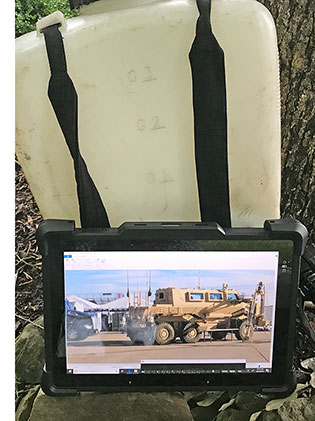 First, as technology develops, chips add more cores and threads, memory and storage make huge leaps forward, and graphics subsystems change, bechmarks often produce "apples and oranges" results. And that's the reason why benchmark developers have to adapt their software with new tests and new weighting. That means benchmark test results cannot be compared across versions (which is the main reason why we've stuck with PassMark v6.1 for so long). First, as technology develops, chips add more cores and threads, memory and storage make huge leaps forward, and graphics subsystems change, bechmarks often produce "apples and oranges" results. And that's the reason why benchmark developers have to adapt their software with new tests and new weighting. That means benchmark test results cannot be compared across versions (which is the main reason why we've stuck with PassMark v6.1 for so long).
Second, not only is the performance difference between SATA- and PCIe-based storage very large, it seems equally large between older and newer PCIe modules as well as lower and higher end models. For example, a comparison between the Samsung NVMe 960 PRO 512GB PCIe M.2 module in the MobileDemand T1270 and the Intel 600p Series NVMe module that was in the Xplore R12 of a year ago on the userbenchmark.com site is peppered with "much faster" and "hugely faster" in favor of the newer Samsung module (see full results here).
Because of that, the overall PassMark score of the xTablet T1270 is that much higher yet. We don't have version 9.0 PassMark results for the R12, but assume the outcome would be the same as with passmark v6.1.
Another example of how large storage performance figures into overall benchmark scores is the comparison between the T1270 and the equally new Xplore XSLATE L10. Although the 8th gen quad-core i7-8650 chip in the L10 annihilates the dual-core i7-7500U in processor performance, the quicker PCIe storage and the very fast dual-channel memory in the T1270 keeps the battle very close with PassMark v9. The xTablet T1270 is one fast machine!
A look inside
The xTablet T270's purposeful exterior design leaves no doubt that this is a rugged machine, but what does it look like inside? Here at RuggedPCReview we always take test machines apart to see for ourselves (and to afford you, the reader, the same).
That begins with the Lithium-Ion battery that is recessed flush into the backside of the tablet so it can quickly and easily be replaced; the internal, non-replaceable batteries used in most consumer tablets would be unacceptable to most business users.  A friction lever with a push button activator securely holds the battery in place, making it unlikely that it'll come loose accidentally. A friction lever with a push button activator securely holds the battery in place, making it unlikely that it'll come loose accidentally.
Since there is no battery compartment cover, the battery contact area has a rubber seal that presses against the magnesium frame to make a watertight seal. Whenever replacing the battery, make sure the seal is fully intact.
The battery itself is rated at 7.6 Volt, 6,200 mAH, for a total of 47 watt-hours. That's not an awful lot for such a powerful machine. Better get a spare or two for work in the field (MobileDemand offers "toaster style" battery chargers to charge the spare batteries in bulk, up to four at a time).
Like many mobile devices, the xTablet T1270 has individual access doors in the back to get to RAM, wireless, mass storage, and other areas. Each of the thin, tough plastic covers is secured with a number of small Philips screws. Note that one of the two covers also include the fingerprint scanner and Smart Card reader, so there are two ribbon cables that connect to the motherboard.
The housing of the xTablet T1270 consists of a frontal box and then a back cover, held together by about 20 small Philips screws. To separate the halves, first remove the back parts of the four protective bumpers, then remove all the screws. The halves come apart fairly easily. Sealing between the halves is of a tongue-and-groove design, with a very thin white silicon seal sitting in the groove around the perimeter of the back plate. Make sure that is sitting properly and is undamaged when reassembling the tablet.
Below you can see the xTablet T1270 taken apart, with its top and bottom parts sitting side by side.
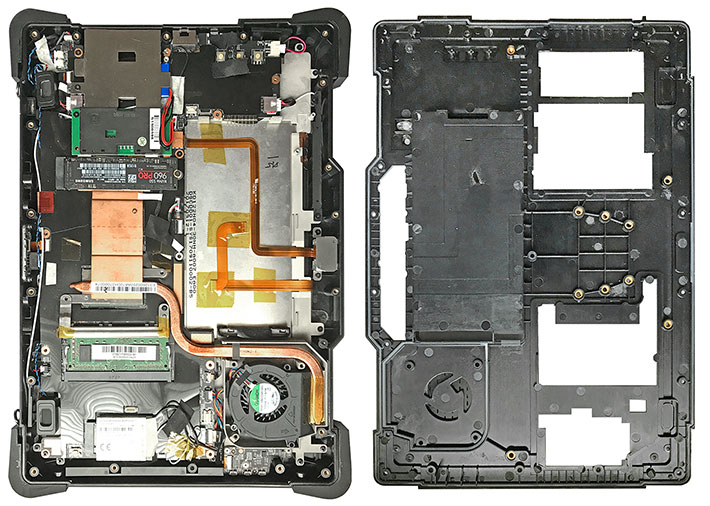
As is plainly obvious, this is no consumer tablet with a tiny hyper-miniaturized circuitboard that with all functionality integrated. Instead, there is a large, complex motherboard that fills the entire real estate inside, much like in a high-performance laptop. There are numerous modules, add-ons, and a good number of wires, many of which will likely be out of sight in final production units. The tablet is built around a strong and very rigid magnesium chassis with cutouts for access to replaceable standard and optional modules.
Proper thermal management and engineering are crucial in a high-performance tablet, and so it's no surprise that there's plenty of visible copper tubing and heatsinking, all designed to collect heat and guide it to the heat exchanger next to the unit's small fan. The fan is sitting in its own enclave compartment inside the tablet, so that it's technically on the outside of the tablet. Liquids won't hurt the fan.
 To the right, another look at the speedy Samsung NVMe solid state disk. It's mindboggling that a module about the size of a stick of chewing gum can provide a half a terabyte of super-fast mass storage. To the right, another look at the speedy Samsung NVMe solid state disk. It's mindboggling that a module about the size of a stick of chewing gum can provide a half a terabyte of super-fast mass storage.
Just to put that in perspective, back in 1983 the first IBM PC XT stunned the world with a big, hulking 10MB hard disk. The little stick of gum inside the xTablet T1270 can accommodate 500,000 times as much data.
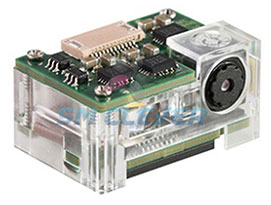 Our eval unit came with an unbuffered 8GB Hynix DDR4 PC4-2400 SDRAM DIMM in the tablet's visible RAM slot, securely held in place with a padded bracket. A second RAM slot sits behind it, and was equipped with a second 8GB module. There also was a Sierra Wireless AirPrime EM7455 Qualcomm 4G WWAN module. Our eval unit came with an unbuffered 8GB Hynix DDR4 PC4-2400 SDRAM DIMM in the tablet's visible RAM slot, securely held in place with a padded bracket. A second RAM slot sits behind it, and was equipped with a second 8GB module. There also was a Sierra Wireless AirPrime EM7455 Qualcomm 4G WWAN module.
Also present was the optional Honeywell N3680 high-performance 2D barcode scanner (see here) with Adaptus 6.0 technology. The N3680 supports a wide set of 1D and 2D barcode symbologies, along with advanced imaging capabilities such as reading poorly printed bar codes and reading barcodes directly off smartphone screens.
Below is a closer look at some details. On the left the small waterproof fan that removes heat from the processor and ancillary electronics, enabling the T1270 to perform at a high level even under extreme operating conditions. In the middle the Sierra Wireless AirPrime WWAN module, and on the right a closer look at the silicone seal inside the tongue-and-grove channel on the back plate.

12.2-inch display larger than most
We've always felt that each type of mobile computing devices has an optimal display size that, for a variety of reasons, works best for the kind of use the class was created for. Interestingly, that's only true to a certain extent. Prevailing screen sizes for phones, tablets and notebooks have been going up and down quite dramatically over the years, often without easily discernible reason. 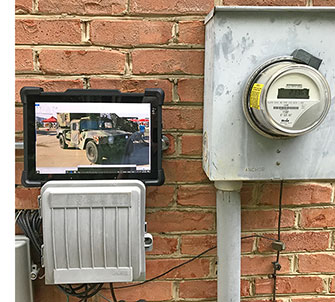 Fashion contributed, but perhaps even more so the never-ending quest to differentiate products from one another. With devices that are often very much the same, what better way to stand out than to make them either ever smaller or ever larger? Fashion contributed, but perhaps even more so the never-ending quest to differentiate products from one another. With devices that are often very much the same, what better way to stand out than to make them either ever smaller or ever larger?
Technology certainly comes into play. Windows, designed for desktop monitors, definitely benefits from as much screen real estate as possible. Having a screen that's large enough to comfortably use Windows is a welcome option for many users.
And with a diagonal screen size of 12.2 inches, the xTablet T1270 indeed offers a generous amount of display real estate. It's a good third more area than on a 10-inch class tablet. In an era where many smartphones have full 4k displays, 1,920 x 1,200 is no longer at the leading edge, but it still well suited for this size display.
The T1270 display offers about 800 nits brightness. That is significantly more than your average consumer tablet, and bright enough for most outdoors applications. Since strong backlights draw a lot of power, the T1270 uses its light sensor to automatically adjust screen brightness.
Overall, like most tablets with glossy multi-touch displays, the T1270 has some reflection issues in high-contrast environments, perhaps a bit more than we like. On the plus side, it is very bright, has very good contrast, and remains viewable from any angle, without the dreaded color shifting of lesser displays. There is a slight degradation in brightness when the screen is viewed from extreme angles, likely the result of the slight anti-glare component of the display surface, but not to an extent where it becomes an issue.
Cameras, conventional and depth-sensing
Like most contemporary tablets, the xTablet T1270 has two integrated cameras. The user-facing 2mp camera is for video conferencing and it is also Windows Hello compatible, whereas the rear-facing 8mp auto-focus camera with LED flash can be used for documentation purposes.
As far as Windows Hello compatibility goes, what is Windows Hello? In essence a quicker and safer way to log in to a Windows 10 device via biometric identification. In the xTablet T1270, it's a facial scan.
But there's more. Underneath the slightly protruding cover on the back side of the tablet (shown below) is room for an optional Intel RealSense Depth Camera D415.

The RealSense is camera system that uses stereo vision to calculate depth. It does that via dual depth sensors, an RGB sensor, and an infrared projector.  The way it works is that the IR projector is scanning an object with infrared light. The two IR cameras record that information, providing a stereoscopic view of the object that then allows computation of depth. This information can then either be superimposed on an image visible to the human eye, or it can be used for all sorts of computations. The way it works is that the IR projector is scanning an object with infrared light. The two IR cameras record that information, providing a stereoscopic view of the object that then allows computation of depth. This information can then either be superimposed on an image visible to the human eye, or it can be used for all sorts of computations.
MobileDemand has actually been a pioneer in making this technology available. In October 2016 we reviewed the company's xTablet T8650 that used an earlier version of an Intel RealSense camera system and found its potential quite promising (see xTablet T8650 review).
What are some of the applications of 3D depth sensing? One application we tested is automatic dimensioning of pallets and boxes, making measuring and processing much faster. Airlines, for example, can quickly measure cargo and luggage automatically utilizing a mobile rugged tablet. Industrial applications can include 3D scanning and modeling of assets and facilities. Warehousing, distribution, transportation/logistics, manufacturing can all benefit from capturing box automated volume dimensioning. Law enforcement, public safety, healthcare, and insurance can use 3D modeling. Builders can accelerate surveys for estimates. Utilities and many others can use 3D scanning for asset management
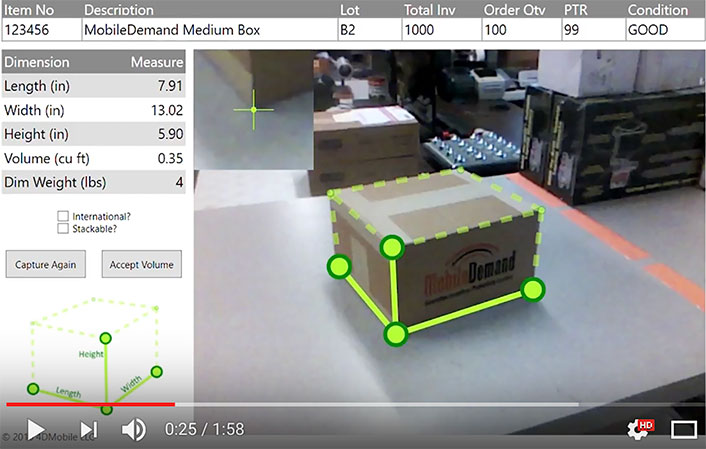
All of this is a work and technology in progress, but it's very easy to see how spatial awareness can be used for an emerging range of productivity-enhancing 3D measuring applications. And having it available in a high-performance rugged tablet such as the xTablet T1270 is a natural.
Ruggedness
MobileDemand management's goal has long been for the world to consider their company name as synonymous with "rugged Tablet PC." So the xTablet T1270, even though it is a fairly large and heavy device, will still be expected to offer all the ruggedness and sealing customers expect from a fully rugged device.
For drops, MobileDemand generally conducts its testing in a manner that makes more real-world sense than the procedures described in MIL-STD-810G, Method 516.6, Procedure IV. The MIL-STD, for example, allows testing to be divided among up to five samples, and the units do not have to be on. Out there in the field, users don't bring along four spares, and whatever they drop is usually powered on.
So MobileDemand did 26 drops to the same and powered on unit onto plywood over concrete. The drop is from 48 inches the MIL-STD likes because when you drop a unit while standing it's from roughly four feet. We are, however, with MobileDemand on this one.
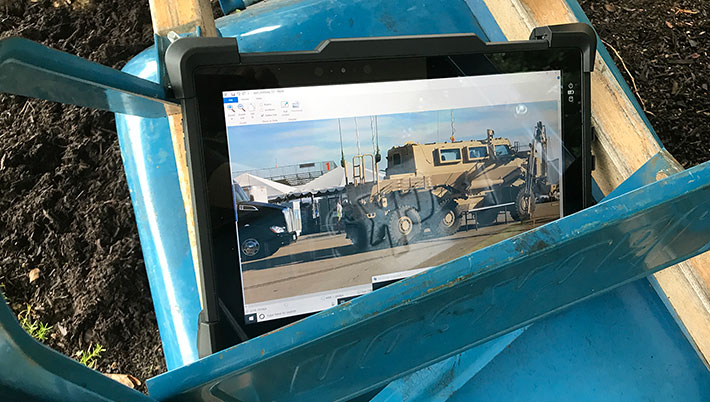
The operating temperature range is given as 14 to 122 degrees Fahrenheit (-10 to 50 centigrade). That is narrower than that of the company's ultra-rugged models, but it's good enough for most operating environments, including commercial freezers, although there are places on earth where it gets hotter and colder than that.
The T1270 is said to withstand shock and vibration resistance in testing similar to MIL-STD-810G, Method 514.6, Procedure I, Category 24, Fig 514.6E-1 which vibrates the unit while it is powered on at prescribed frequencies for an hour per axis. This test does not simulate an actual application environment, but rather suggests that a device that can pass that test will survive in the field.
For sealing against the elements, MobileDemand claims IP65-level ingress protection. The "6" means complete protection against dust, and the "5" means protection against low pressure water jets from all directions. In essence, the xTablet T1270 can handle any degree of rain, but it shouldn't be hosed down with a pressure washer or submerged into water. And keep in mind that the port cover must be firmly in place and all seals must be undamaged in order to provide that protection.
 But what about the T1270's large glass surface? We're told it's chemically hardened to a surface hardness of 7H, which is harder than regular window glass or a knife blade (those are about 5.5H), harder than pumice (6) and harder even than a steel file (6.5H). But what about the T1270's large glass surface? We're told it's chemically hardened to a surface hardness of 7H, which is harder than regular window glass or a knife blade (those are about 5.5H), harder than pumice (6) and harder even than a steel file (6.5H).
On top of that, the xTablet T1270 uses a screen protector similar to the one the company applies to its other tablets. It offers extra protection, and also an oleophobic coating that improves touch performance in rain.
Apart from the printed specs, our examination of the xTablet T1270 revealed a remarkably sturdy design and construction, especially for such a slender tablet design. A strong magnesium chassis keeps the unit from flexing, guarding against display breakage. Additional protection is provided by the low-tech but very effective and easily replaceable corner rubber bumpers.
Bottom line: MobileDemand xTablet T1270
When MobileDemand sent us their xTablet T1270 for review in early June 2018, they emphasized that the platform had not been entirely finalized and that there may be changes. So would we please concentrate on performance testing. Well, one thing led to another and we ended up doing more than just performance testing. That's because although there were still some rough edges on our tester, overall this is a compelling design.
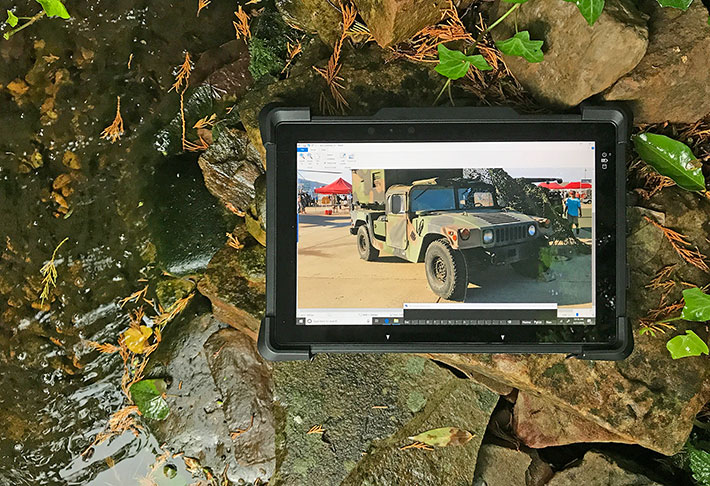
The xTablet T1270 is definitely high performance, at least when ordered with one of the two high-end Intel "Kaby Lake" Core processors. Combine that with speedy PCIe-based NVMe solid state disks (very highly recommended) and dual channel RAM, and the xTablet T1270 is a beast. As of this writing, it's the fastest dual-core Windows tablet we ever tested, and the overall fastest large-screen (over 11 inches) tablet we ever tested. And a fan means performance won't tank when it gets hot.
The xTablet T1270 has a satisfyingly large 12.2-inch display with 1920 x 1200 pixel wide-format resolution that remains usable outdoors. The capacitive multi-touch screen is very responsive and even works with thin gloves.
Thanks to its strong magnesium chassis, solid design, and nicely integrated corner bumpers, the xTablet seems tough and rugged enough for the field. IP65 ingress protection means the tablet is dustproof and can easily handle any amount of rain. Many customers will use the device in a mounted environment, but weighing 4.3 pounds it's still light enough for mobile use.
Now add to that the availability of an integrated Intel RealSense depth camera system, and the xTablet T1270's potential as the high performance tablet hardware for an emerging range of productivity-enhancing 3D measuring and modeling applications is obvious.
-- Conrad H. Blickenstorfer, August 2018
MobileDemand xTablet T1270 Specs:
| Type |
High-performance rugged Tablet PC
|
| Added |
Review 08/2018
|
| Processor |
Test unit: Intel "Kaby Lake" Core i7-7500U (Intel Core i5-7200U standard; optional Celeron CPU)
|
| Processor speed |
2.7GHz (3.50GHz turbo)
|
| CPU Thermal Design Power |
15 watts |
| Graphics Chipset |
Intel HD Graphics 620 (300MHz to 1.05GHz) |
| OS |
Windows 10 Professional (64-bit) |
| Memory |
8GB DDR4 RAM standard; optional 16GB DDR4 RAM dual channel |
| Display |
TFT LCD with oleophobic, scratch-resistant, chemically strengthened glass protector, 800 nits luminance |
| Display size/res |
12.2" HD (1920 x 1200 pixel, 186 ppi) |
| Digitizer |
10-point capacitive multi-touch; glove touch; anti-water drop; optional active digitizer pen |
| Keyboard |
Onscreen keyboard + optional external |
| Storage |
128GB, 250GB, or 500GB SSD; 1TB high performance PCIe SSD coming soon |
| Expansion slots |
1 x microSDXC, 1 x micro-SIM card, optional MSR/Smart Card reader |
| Housing |
Plastic with rubber bumpers over magnesium chassis |
| Size |
12.5 x 8.4 x 1.1 (318 x 215 x 29)
|
| Weight |
4.3 lbs. (1.95 kg) in base configuration |
| Operating temperature |
14° to +122°F (-10° to +50°C) |
| Ingress protection |
IP65
|
| Drop/shock |
MIL-STD 810G with 4 foot drop height |
| Certifications |
FCC, CE and IC
|
| Power |
Replaceable 7.6V 6,200mAH 47 watt-hour Li-Ion; 143mAh backup battery for 60 second hot-swapping |
| Cameras |
front-facing 2MP auto-focus vidcam with Windows Hello support; rear-facing 8MP auto-focus w/ flash; optional Intel RealSense D415 3D Camera |
| Scanner |
Optional Honeywell N3680 high-performance 2D barcode scanner |
| Security |
TPM 2.0; optional: Windows Hello for facial recognition, Windows Hello for fingerprint, Smart Card reader, RFID/NFC |
| Sensors |
Gyro, accelerometer, e-compass, ambient light, proximity |
| Data capture |
Optional: NFC/RFID reader, 1D/2D scanner, Mag Stripe Reader |
| Interface |
1 x USB 3.0, 1 x micro HDMI, 1 x RJ45, audio in/out, dock, 2 x external RF antenna connectors |
| Wireless options |
802.11 a/b/g/n/ac WiFi with Bluetooth v4.2; optional: uBlox NEO-M8N GNSS (concurrent GPS/QZSS, GLONASS, BeiDou), 4G LTE WWAN (Sierra EM7455: LTE FDD: Band B1-B5, B7, B12, B13, B17, B20, B25, B26, B29, B30, B41; UMTS/HSPA+: B1-B5, B8)
|
| Price |
Inquire
|
| Warranty |
3 year standard warranty; extended warranty and service plans available
|
| Web |
xTablet T1270 web page |
| Spec sheet |
 xTablet T1270 PDF spec sheet xTablet T1270 PDF spec sheet |
| Contact |
MobileDemand
1501 Boyson Square Drive, Suite 101
Hiawatha, IA 52233
Phone: 319.363.4121
|
(copyright 2018 RuggedPCReview.com)
|




